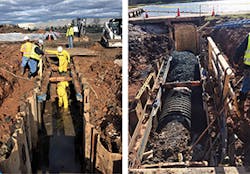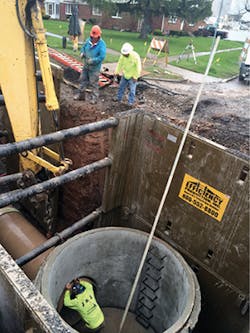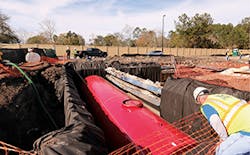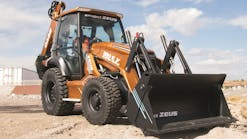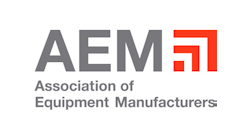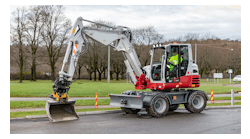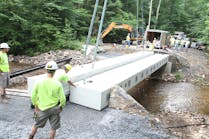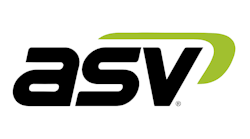Opportunities abound for grading and excavation contractors looking to do pipeline work.
There are new pipelines being installed to accommodate the needs of a growing population: water, sewer, recycled water, stormwater, gas, and oil.
There is the remediation needed of the US underground pipeline infrastructure, to which the American Society of Civil Engineers has given poor grades.
In ascertaining a job site’s needs, one must consider the bigger picture, notes Tom Hartman, senior vice president of strategic alliances for National Trench Safety.
“Where are you working? Are there adjacent structures? Is it down the middle of the street? Are you going to have traffic concerns? What equipment is needed? If you’re installing an 8-inch PVC sewer line with a rubber tire backhoe, then it’s not really practical to use an 8-foot-tall by 20-foot-long steel shield that the backhoe won’t lift. You may elect to use a smaller aluminum shield or an aluminum hydraulic shore for those systems.”
Pipe size isn’t the ultimate determinate when designing a trench solution, but it is one factor, notes Blake Smith, sales and marketing manager for United Rentals Trench Safety.
Other considerations include soil conditions, adjacent structures, the project timeline, the type of pipe, and the presence of underground utilities.
One must always be prepared for the unknown, points out Smith.
“Employee safety, project productivity, and the comparative cost of different solutions are all important, he says, adding that United Rentals Trench Safety has an in-house engineering department registered in the US and Canada with teams focused on project safety and ongoing innovation.
“When we design a solution, it can be based on slide rail, mega brace and sheeting, customer trench shields, beam and plate, hydraulic solutions, or any combination of these, typically with a training component,” adds Smith.
Contractors need to consider how quickly they can dig, shore, and install the pipe, points out Hartman.
A couple of pipeline trenching and shoring projects by Mabey Inc.
“Most agencies aren’t going to allow you to open up unlimited amounts of trench and only shore the portion you’re working in and barricade the rest,” he says. “They’re going to want it to be ‘cut and cover’ as you go. The quicker a contractor can do that, get the utility installed, compact it, cover it back up, and open it up to paving will determine how much equipment is needed on the site. The rule of thumb is what more do you need so you can leap-frog forward?”
Hartman notes that decisions that impact the choice of a trench safety plan include depth and width of the trench, size and weight of the pipe/conduit, adjacent utilities/structures, equipment available, and the estimated production.
Three main options include shoring, sloping, or shielding, he says.
Shoring is a method of applying an active load to prevent any movement whatsoever of the trench walls because there may be a structure such as a utility adjacent to it, says Hartman.
Shoring can be addressed through a myriad of systems, such as slide rail systems and hydraulic shoring, he adds.
“You’ll see sloping used if you see a large natural gas pipeline running out in the middle of nowhere through a field in the country,” says Hartman. “You’ll see miles of pipe that are being welded and laid together.
“The trench is excavated and the trench walls are laid back at an angle. That requires a lot of additional digging with the machines to make that safe. Occupational Safety and Health Administration [OSHA] regulations address what slopes can be used for different soils instead of having vertical walls.”
That method is “obviously not practical if you’re replacing or repairing a line down the middle of a street in San Francisco,” he points out. “You can’t just lay the soil back and open up a trench that might be 25 feet wide where there are adjacent structures and utilities already in place.”
Shielding is a method that is “in-between” shoring and sloping, says Hartman. A shield of steel or aluminum boxes is used to protect the workers while they are preparing the grade, and installing and connecting the pipe.
“It doesn’t necessarily protect the adjacent structures,” he adds. “You can’t just set a shield in the middle of a big hole and say you’re safe. Let’s say the trench is 5 feet wide. The shield will be maybe 4 foot, 6 inches, leaving just a small gap between the trench walls and protect the workers.”
Some contractors will use a combination of sloping and shields.
“If they have to dig deep in the middle of nowhere, say 35 or 40 feet, there are very few machines that can actually go to that depth, so they’ll have to step it down, bench it down, or slope it down,” says Hartman. “When they get to a practical depth limit of 20 to 25 feet, then they’ll put in shields for the last amount.”
Shields are popular and used often for larger installations—such as sanitary sewer lines and storm drains—for heavy equipment such as large excavators that can handle the shields, says Hartman.
“They’re not really designed to provide the same level of support to the trench walls as the shoring system is,” he adds.
As trenches and excavations are generally considered confined spaces, contractors also need to ensure they are addressing related concerns with gas detection, rescue retrieval, and fall protection equipment, notes Hartman.
Pipeline workers have many variables to consider when starting a project, including its size and scope, notes Mitch Post, training and development supervisor for Mabey.
“Moving large amounts of soil requires a plan, and trenching work isn’t a one-size-fits-all business,” points out Post. “Having the right plan and selecting the right trenching system can make all the difference when trying to meet the deadline and the budget.”
Efficiency Production manufactures underground production and safety equipment—as well as production support equipment—and is the original manufacturer of trench boxes, notes Mike Ross, national training coordinator for Efficiency Production.
Trench boxes or trench shields are moving boxes installed with an excavator or backhoe, and then are pulled along the pipeline or trench, providing a temporary opening in which the pipe is placed and then usually concurrently backfilled right behind it, says Ross.
In choosing equipment, contractors need to consider soil type and depth ratings, says Tommy Marciniak, marketing manager for Trinity Shoring Products, of which Pro-Tec is a sales division.
“For the most part in the industry, we assume everything is a C-60 soil, which is the standard of 60 tons per square foot of soil,” he says, adding that the soil could be “better or worse.”
In wide open areas with cohesive soil, crews may choose to open-cut or slope the trench, says Post, noting it is often the quickest way to complete a job as long as there is enough room to work and no need to truck soil off of the site.
“It’s also generally safe, provided the crew understands OSHA standards for sloping,” says Post.
In some cases, open-cutting a trench is impractical, he adds.
“In areas with limited space to work or job sites with adjacent roads, bridges, or other infrastructure, pipeliners have to take a more compact approach,” says Post. “This is where specialized equipment such as trench boxes and shoring systems come into play. Installation of one of these systems can allow the crew to work safely in a trench that is limited to just the size they need for the pipe being installed.”
Even those systems are not one-size-fits-all and can range from simple trench boxes that can be dragged along the length of the trench to engineered shoring systems that can be installed to “leap-frog” down the trench as sections of pipe are installed, says Post.
When evaluating shoring requirements for pipelines, one of the first considerations is where the pipe is going to be welded, notes Keith Lamberson, president of Trench Shoring Services.
“Aboveground and then lowered into the open excavation with side booms is quite common and requires very little as pertains to shoring,” he says. “An alternative is to lower pipe sections into the open excavation and then weld in place. When this method is used, shoring in the form of welding huts is typical. The welding hut is used only at the point that the employee is welding and exposed to potential for cave-ins.”
In addition to the long lengths of open excavation and the welding procedures, another consideration is “road crossings” either by open trench or by bore pits, points out Lamberson.
“Bore pits and receiving pits have to be sized around the boring equipment being used as much as the pipeline diameter,” he says. “Often, bore pits for pipelines are longer than bore pits for water or sewer projects. This happens because the pipelines require greater distances to change elevation and get lowered to the required depths.”
Sewer and water pipe in lengths of 20 feet or less is generally trench box work, says Ross, adding that is a general method used in the Midwest and eastern US.
For long pipeline installations or unstable ground where using trend shields is unproductive, shoring systems such as linear slide rails are used, says Ross.
“If you use bays, they attach to each other to create a much longer open trench,” he says. “It’s called a leap-frog system where you have one crew ahead installing and shoring down the grade and maybe laying the pipe.
Efficiency Production working with a manhole shield
“Maybe you’ve got a second crew in the middle laying 55-foot-long or longer pipe. A lot of times, it’s welded or has some kind of premium joint that requires quite a bit of time and then the guys straight behind the back of the system are backfilling the trench, pulling the system out, and moving the equipment out to the front or leap-frogging it up to the crew up front that buries it again. It’s the same concept as a trench box. You have an open area to lay the pipe, but it’s much longer. It could be 100 feet or 200 feet long.”
In other applications in the West and Southwest, hydraulic shoring is used for production, says Ross.
“They use the same concept where they have a machine digging a long open trench and then they will use small hand-set or light-set with light equipment hydraulic shores,” he says. “They’ll hold the trench open, lay the pipe behind, and then backfill and move more shores up to the digging machine. They use that for both short-length and long-length pipe. They use smaller machines and their pipe is not as deep as it is in the cold weather places.”
Open-cut or “sloped” trenches must be sloped back beyond the maximum allowable slope, says Post. Trenches using shielding systems such as trench boxes have to have boxes rated for the depths of the trench and the boxes need to be properly installed. Trenches using shoring systems, such as slide rail or sheet piling, should be designed by a professional engineer with the systems installed exactly according to the engineering plan, he adds.
Infrastructure utilities can be especially challenging as they require an in-depth knowledge of the systems for sewer, water, storm sewer, and plant-specific applications, notes Smith.
“One of the most common pipeline excavations is for sewer-related lift station installations,” he says. “The depth can be a challenge and is often made more difficult by adjacent structures, existing utility lines, confined spaces, limited access and egress, and other obstacles.”
An excavation for a lift station installation will typically use trench shields, slide rail, sheeting, and bracing, points out Smith.
Another challenging application is a large-diameter water line that requires specific vertical clearance, he adds. Vertical clearance is defined from the bottom of the excavation to the first cross-strut of the shoring or shielding system.
“Trench shields with high arch spreaders are one solution that accommodates the vertical clearance required to work safely and boost production,” says Smith.
Marciniak says choices for techniques and procedures not only depend on the depth and length of the installed pipes, but also the equipment excavating contractors have onsite.
Smaller equipment for more shallow pipelines typically calls for trench shielding equipment.
For crews using medium-sized machines of 30,000–60,000 pounds, Pro-Tec Equipment recommends its Pro4-1012 (10 feet tall by 12 feet long) trench shields, designed with more pipe clearance than its standard shields (85 inches versus 70 inches of vertical clearance) while providing sufficient room for pipe installation.
For those not concerned with wide load permits, the company offers the Pro4-812 (8 feet tall by 12 feet long) trench shield, designed with more pipe clearance than its standard shields (64 inches versus 55 inches of vertical clearance) while providing enough room to install the pipe.
Both shields are usually paired with a set of 10-foot- or 12-foot-wide spreaders.
For crews using smaller-sized machines, Pro-Tec Equipment recommends its Pal3-812 (8 feet tall by 12 feet long) trench shield, fitted with its Pipeline Arch. For contractors seeking an even lighter system, Pro-Tec Equipment recommends its ATS or MOD system paired with an Aluminum High Clearance Arch. Both allow for 72 inches of vertical pipe clearance when paired with any 8-foot-tall Pal3 trench shield.
These two systems can be paired with any number of the arch extensions to provide the needed width.
A longer, deeper pipeline project necessitates a linear slide rail shoring system—a dig-and-push system that can be leap-frogged along the entire excavation of the pipeline, says Marciniak.
According to the company’s website, it is installed from the top down and removed from the bottom up, minimizing size of excavations, soil disturbances, and restoration time and cost. The installation is done with low vibration, providing soil support for excavations, adjacent structures, and existing utilities.
The system also is used in bad soil conditions, lift/pump station installations, tight quarters, fuel tank installations, cast-in-place foundations and footings, and boring and receiving pits.
Much of the needed equipment can be purchased or rented and companies that offer it also offer safety training.
For instance, National Trench Safety offers a variety of items for pipeline excavation jobs:
- Hydraulic vertical shores, which are lightweight shoring devices that are pressurized against a trench wall to provide proactive soil support
- Hydraulic walers, which are a lightweight shoring system similar to hydraulic vertical shores, except that the system utilizes horizontal rails to provide proactive soil support and can yield increased time efficiencies
- Aluminum trench shields, which provide lightweight soil protection—configurations include standard hydraulic, static, modular, and the Lite Guard aluminum shields
- Conventional steel trench shields, designed to protect workers should a cave-in occur
- Steel arch spreaders, used as an accessory for steel trench shields to provide improved vertical clearance
- Steel and hydraulic manhole shields
- Slide rail systems and accessories
- Beam and plate systems
- Hydraulic excavation braces
- Steel sheeting frames to provide soil support
- Trench fall protection products
- Traffic signage and protection products
- Light towers
- Pipe plugs
- Hydrostatic test pump and pipe joint testers
- Confined space and other specialty equipment
While pipeline installation work can command decent revenues for contractors, the most important factor in the return on investment of equipment and crews is safety.
“Workers who choose to work in the underground industry have a 112% better chance of being killed in their career than general trades,” notes Ross.
The National Institute for Occupational Safety and Health reports on its website that a review of national databases by its researchers found that trenching and excavation hazards during construction activities resulted in 488 deaths between 1992 and 2000, an average of 54 fatalities each year.
Some 68% of those fatalities occurred in companies with fewer than 50 workers; 46% occurred in small companies with 10 or fewer workers.
Safety protocols should always start with a job-site plan and a consultation in the field, points out Smith.
United Rentals’ field representatives review site plans, walk the project with the customer, and discuss all safety hazards.
“One of the many considerations is whether excessive groundwater will affect the design of the shoring solution,” says Smith, adding the company’s pump solutions and trench safety teams work together to address fluid issues.
Safety training and ongoing safety meetings—as well as mapping out the potential hazards—cannot be understated.
For safety’s sake in excavations, contractors must work with manufacturers’ serialized specific tabulated data and OSHA 29 CFR 1926 Subpart P for excavations and trenching, as well as state and local regulations, especially as the job site encroaches on public spaces, says Hartman.
Trenching and excavating rules are specific in that anything more than 5 feet in depth requires contractors to take means to address the safety of the workers in the trenches as well as the general public, notes Hartman.
One of the main components of the OSHA regulations is that a “competent person” needs to be onsite while the work is being performed to make those decisions, he points out.
OSHA defines the “competent person” as “one who is capable of identifying existing and predictable hazards in the surroundings or working conditions which are unsanitary, hazardous, or dangerous to employees, and who has authorization to take prompt corrective measures to eliminate them.”
Through training and/or experience, the “competent person” is knowledgeable of applicable standards, is capable of identifying workplace hazards relating to the specific operation, and has the authority to correct them, according to OSHA.
“The ‘competent person’ needs to be someone who is trained and knowledgeable in selecting safety systems based on analyzing the soils that they are working in and has the authority to make decisions to go or not go,” says Hartman.
Like most companies in the industry, National Trench Safety offers training services, such as its eight-hour “competent person” class. United Rentals also offers training for “competent persons.”
“As a general rule and with good practices, most contractors will have all of their employees go through this training if they’re involved in trenching and excavating and they’re working in, near, or around the trench,” says Hartman.
“Not everyone can be a ‘competent person’ just as not everyone can be the boss on a job, but it is good that everyone be aware of the hazards that are present, safe practices, and the use of systems,” he adds.
“Say the foreman who is the designated competent person has to leave for a period of time and he wants work to go on—maybe he can designate who can take over the role of the ‘competent person’ and decide if the work continues to go forward.”
“The idea of the ‘competent person’ is a beautiful thing as far as a solution,” says Ross. “It allows the ‘competent person’ to adjust their design so they can accommodate whatever hazard it is that they find.”
“You don’t know what’s there until you find it,” adds Ross. “Pipeline operations are constantly changing. As you go down the line, it’s ever-evolving based on water, soil, and different conditions.”
Mabey Inc. working on a tank installation
While the “competent person” must eliminate all known or predictable hazards, they are not locked into one way of doing it as long as they stay within the underground standards of subpart P and within the limits of the equipment they’re using, says Ross, adding that his company provides safety training.
“There is a person there who has the flexibility and responsibility to fix it and eliminate it. But I think the lack of training and the lack of understanding that that is their job and they have that flexibility is a shortcoming in the US,” he adds. “The one thing I run into more often is a little misunderstanding of the role of the ‘competent person,’ what their expectations are and what their authority is, which should come from their employer.
“They understand they have the responsibility, but they are really not clear on where their authority is,” says Ross. “They wonder: ‘Do I get to this point and stop? How far can I decide on my own without getting additional help?’ People know the rules, they just don’t understand what they can change.”
Injuries and death often occurs because of the weight of the soils, says Hartman.
“A cubic yard of soil is going to weigh almost 3,000 pounds and that’s only 3 by 3 by 3 feet, so it’s not a whole lot,” he says. “What’s interesting is in a trenching and cave-in accident, usually it starts with the primary person, who was a laborer. The low man on the totem pole in the job would be in the trench for whatever reason. Maybe it wasn’t shored or was improperly shored, but the cave-in happened and he’s injured.
“Secondary injuries almost always happen to supervisors because they were attempting to perform a rescue to get the person out of the trench. People are trained [so that] if something does happen, you first walk up to make sure that you shore it up before you just jump in. It’s human nature to try to save the guy.”
Marciniak points out OSHA regulations cover such issues as the location of the spoil pile, how far the trench shield can hang from the bottom of the excavation, and the input of professional engineers, among other factors.
Special attention needs to be paid to surcharge loads created by the pipeline spread working near the edge of the open excavation, notes Lamberson.
While OSHA provides guidelines, the types of protective systems used are left almost entirely up to the contractor, says Post.
If the crew is sloping a trench, it must be sloped back beyond the soil’s “maximum allowable slope” or the angle at which the soil will remain stable and prevent a collapse, he says.
“This requires having a trained ‘competent person’ who can conduct basic soil testing and determine a safe slope angle,” says Post. “When using trench boxes, the box itself must be rated for the depths at which it will be used. These depth ratings also are subject to soil type, so a basic knowledge of soil testing is important for any type of excavation work.”
In situations where sloping or trench boxes won’t provide sufficient protection, engineered shoring systems come into play, says Post.
“When using slide rail or sheet piling systems, pipeliners will get an engineered design that assures a safe excavation,” he adds.
Most safety protocols regarding trench boxes or shields focus on depth limits, says Ross.
Citing the OSHA 5-foot limit, one of the most significant safety issues is to refuse to dig without any kind of protective system in depths greater than 5 feet deep and in anything less than 5 feet if it’s unstable ground, says Ross.
“It’s exposing employees to a hazard because you are using the wrong method,” he adds.
Not using any safety measures or using the wrong ones is what causes incidents and accidents, says Ross.
“Then you modify your operations to use the tool, but in doing so you create an unsafe environment because it’s the wrong tool,” he adds.
Case in point: crossing utilities can present challenges.
“A trench box is a great item for making production,” says Ross. “Its greatest limitation is trying to cross utilities, especially a mid-depth utility because you can’t get the box through it. You have to get it under it or over it.”
Manufactured systems don’t fail, even when contractors push the limits of the equipment they have, says Ross.
“But a lot of people get hurt in using it outside of not only the prescribed method of OSHA, but also outside the manufacturer’s limit,” he adds.
Crews should stick to their plan and not cut corners on safety, even if they think that an accident won’t happen to them, he says.
“A cubic yard of soil can weigh almost 3,000 pounds and it only takes a second for several yards of soil to break loose and topple into a trench,” he adds.
Ross also cites “wishful thinking” in underground work leading to injuries or deaths.
“It’s common in this business to make assumptions: ‘It will be OK because I got away with this once before,'” says Ross. “The guy rationalizes himself into a bad situation. I don’t believe anyone does anything on purpose to get themselves hurt or killed. Most times, it’s a cumulative thing. You make one assumption or bad decision that in and of itself probably wouldn’t cause a catastrophe, then you compound that by making another one and make a series of bad decisions or assumptions that end up being very serious in the end.”
Looking at photographs after the fact reveals such “wishful thinking,” points out Ross.
Accidents happen when “the guy who was down in the bottom of a hole or trying to get somewhere and was concentrating on trying to complete a task and in his tunnel vision ignored too many ancillary things that were accumulative a big problem,” says Ross.
Even “competent persons” can get “tunnel vision” where they are concentrating on crossing a utility and setting a manhole, ignoring the possibilities of a bad atmosphere such as vapors, or the effects of the water, or the effects of traffic or a nearby railroad, says Ross.
Many of the key safety protocols in trench work extend to all areas of construction.
“Crews should never work in an unprotected excavation for any reason,” says Post. “The fatality rate for excavation collapses is 15 times higher than any other form of construction accident. Workers should avoid working under raised or suspended loads. Personal protective equipment is absolutely mandatory for pipeliners. But mostly, it’s common sense.”
